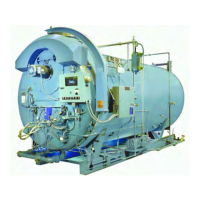Chapter 5 — Starting and Operating Instructions
5-4 Part No. 750-184
Note: The settings of all the above controls may require some
readjustment after the boiler is started and running for a short
period. The scale settings on the controls are relatively
accurate, but are principally for use as guides. Final
adjustment should be based on and agree with the reading of
the steam pressure gauge or the water temperature
thermometer.
Inspect the Low-water Cutoff and Pump Control as well as the
Auxiliary Low-water Cutoff (if equipped with this optional device).
Check for freedom of float movement. Float movement can be
verified by observing the level of water in the gauge glass when the
water supply has been cut off either by the stopping of the feed
pump or by the closing of a valve, and the restarting of the pump or
opening of the valve when water is drained from the pressure vessel.
The importance of proper functioning of low-water controls cannot
be over-emphasized. Be sure that the control and the piping is level.
The settings of controls relating to fuel, either oil or gas, are covered
in subsequent sections.
In the event the boiler is equipped with optional control devices not
listed here, be certain to ascertain that their settings are correct. If
additional information is required, see your local Cleaver-Brooks
authorized representative or contact Cleaver-Brooks.
On initial start-up or whenever the boiler is placed into operation
from a “cold” start, the Manual-automatic Selector Switch should
be set at “manual” and the Manual Flame Control set at “close.”
After the boiler is in operation and thoroughly warmed, the selector
switch should be turned to “automatic,” so that the burner firing
rate may be controlled by the Modulating Control in accordance
with load demands.
Close all power entrance switches (supplied by others).
C. GAS PILOT
The gas pilot should be checked for satisfactory performance prior
to initial firing. Follow the pilot flame adjustment instructions given
in Chapter 6.
On initial starting attempts, several efforts might be required to fully
bleed the pilot line. While checking pilot adjustment, observe
whether the pilot flame is extinguished promptly when the burner
switch is opened. A lingering flame indicates a leaking gas pilot
valve, which is a condition requiring correction before proceeding.
D. ATOMIZING AIR
The supply and pressure of the atomizing air on an oil-fired burner
should be checked. Before starting, inspect the oil pump lube oil
level. Add oil if necessary to bring the level to the mid-point or
slightly higher of the sight glass. Use SAE 20 detergent oil of a grade
mentioned in Chapter 8 and fill in accordance with instructions
given there.

